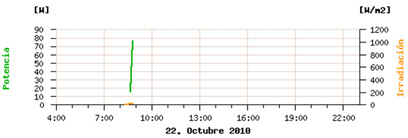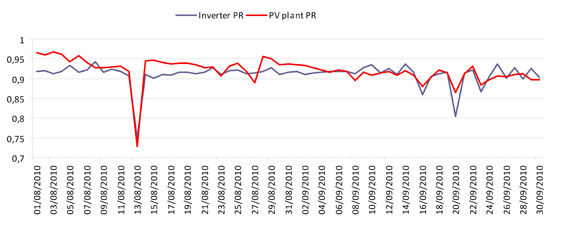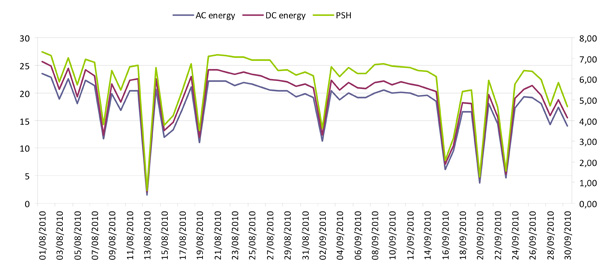Author:
PhD. Salvador Segui Chilet and Victoria Devesa (Universidad Politécnica de Valencia) Velencia, Spain
Date
12/22/2010
A 3.3kWpk photovoltaic installation consisting of 64 amorphous silicon modules was connected to the power grid of the Universidad Politécnica de Valencia (UPV). The plant is located on the terrace roof of the Escuela Técnica Superior de Ingeniería del Diseño and is being used for R&D and training courses in photovoltaic installations. Several companies of the photovoltaic sector (EPVSOLAR, Danfoss, Carlo Gavazzi, Hawi, and others) participate in the project providing different materials: such as inverters, DC boxes and monitoring systems. Installation The 64 EPV-52 solar modules of amorphous silicon (a-Si) manufactured by EPVSOLAR are connected in 8 strings of 8 modules in series each, in a single PV array. With 20° tilt and 18.6° SW orientation the installation is done trying to reach the best architectonic integration of the PV array.

The installation is going to be used for the study of different effects and situations that typically exist in a PV installation using a-Si modules, i.e. the stabilization period, productivity under low radiation conditions, losses due to mismatching or high temperatures, among others. As it is well-known, amorphous silicon modules produce a higher energy yield per installed kWp than typical crystalline modules, even with orientations and tilt angles different to the optimal ones. The Danfoss ULX3600 HV used in the installation is a 3.6kW single-phase inverter with a high frequency transformer and a high DC input voltage range that perfectly fits thin film module voltage characteristics. The inverter has two independent MPP-trackers and an "early start", thanks to the combination of two MPP-tracking methods, exclusively designed to work with high and low irradiation levels. The monitoring of the PV plant is carried out by the Danfoss Web-logger with its corresponding sensors (solar radiation, ambient and module temperatures), as well as by the monitoring system developed by Carlo Gavazzi (named Eos Array), that allows to monitor independently each string of the array (voltage and current). A calibrated cell, two temperature sensors (ambient and module temperatures) and an AC energy counter with S0 pulses output permit the Eos Array to calculate the performance ratio of the installation and the inverter. The Eos Array is configured to store the acquired data every 1 minute, but internally it measures the values every 2 seconds and records the average value of the different magnitudes. Energy harvest For calculating the expected energy harvest, the Peak Sun Hours (equivalent irradiance or PSH in kWh/m2•day) shown in Table 1 have been obtained from http://www.satel-light.com/ and http://re.jrc.ec.europa.eu/pvgis/ for the given conditions of the installation.

From the data supplied by EPVSOLAR, the losses due to high temperatures have been estimated accounting for a 4%. This value is significantly lower compared to crystalline modules (approximately 10%). The global efficiency of the installation (performance ratio or PR) has been estimated approximately to be 0.81, providing an energy harvest between 1357kWh/(kWpk×year) and 1453kWh/(kWpk×year) depending on the used PSH data. Other losses considered in the calculation are as follows: inverter losses (6.6%), conductor losses (1.5%), dirtiness (1 %), reflectance and transmittance losses (1%) and module tolerance (5%). First results of the photovoltaic plant With the Eos Array monitoring system the a-Si module energy harvest in cloudy days, at dawn and dusk, when the portion of diffuse light is higher and the radiation levels lower, can be more accurately evaluated. Due to the specific MPP-tracking algorithm for low irradiation levels included in this inverter, the PV plant starts producing energy already at irradiation levels of 14W/m2, with 280V on the DC side and a DC current equal to 40mA, which means 11W on the PV modules. Figure 1 shows the "early start" feature of the inverter

Other important parameters obtained during the two first months of operation of the photovoltaic plant appear in Table 2. The measured values of PSH are close to the values used in the energy harvest estimation. The DC energy is calculated by the Eos Array using the string voltage and current magnitudes. The plant average efficiency (PR or performance ratio) during both months is higher than 90%. This value is slightly higher than the estimated one (81%) due to the fact that during the stabilization period of the amorphous silicon the rated values can be exceeded (up to 20%).

Figure 2 includes information of the daily average inverter and plant efficiencies while Figure 3 shows daily DC and AC energy and PSH. As it can be observed in Fig. 2, the inverter has reached a peak of average efficiency equal to 94.3%, with an average efficiency around 91%. The peaks corresponding to the minimal efficiencies match the days with lowest irradiation, i.e. 13/08/2010 with a total of 0.68PSH or 20/09/2010 with 1.28PSH.


The produced energy is fed into the power grid of the Universidad Politécnica de Valencia contributing to reduce the energy consumption of the building and becoming an example of an auto-consumption installation, still not included in the current Spanish regulation. Future uses In the next months, more studies concerning the performance of amorphous silicon modules are going to be carried out using the acquired information: stabilization of power, current and voltage magnitudes after the first months of operation; monthly and annually performance ratios, losses due to the effect of temperature, mismatching losses due to differences between the module parameters, etc. This a-Si photovoltaic installation is also used during the practical parts of different training courses developed by the Universidad Politécnica de Valencia in photovoltaic power systems. The on-line course includes a virtual visit, where the student can find a complete description of all the components used in the installation as well as a video showing how the installation works. The data acquired in the installation by Danfoss and Carlo Gavazzi data loggers are used by students to analyze the behavior of this energy resource. This photovoltaic installation clearly shows the active role of the Universidad Politécnica de Valencia in supporting sustainability and environmental concern, with the aim of increasing the public awareness about these issues, especially among internal staff and future professionals. www.cursofotovoltaica.com